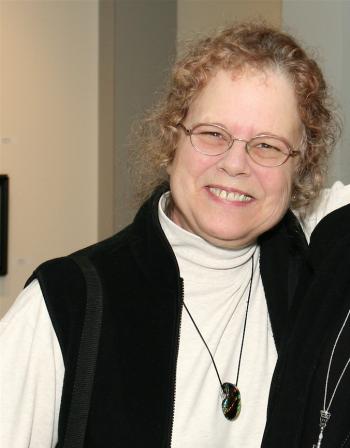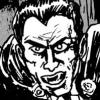Nancy Lukasiewicz Retires After 40 Years; Lyndon House Hires Beth Sale
Art Notes

The Lyndon House Arts Center
The Lyndon House Arts Center sits atop its perch seemingly lost in time, the tree-crested hilltop forming an illusion of unending greenery. March marked the end of an era for the center when Director of Galleries Nancy Lukasiewicz retired from her longtime position.
Over a 40-year career, Lukasiewicz developed hundreds of exhibitions showcasing local culture and history, shaped the lives of thousands of creative children through art camps and classes and secured the long-term sustainability of the center’s public arts programming through tireless grant-writing efforts. As director, Lukasiewicz curated shows featuring active local and regional artists representing the traditional and avant-garde, professional and novice, young and old. Her goal with the Lyndon House was always to give a voice to Athens’ diverse multicultural history, as well as represent the evolving nature of the town.
“Our arts scene is very important to the well-being of our community,” Lukasiewicz reflects. “There is such a variety of types of visual art available in our community. I think it is our strength and the unique richness of Athens that we encompass such variety.”

Nancy Lukasiewicz
Some favorite shows she curated over the years include the biannual exhibition of local schoolchildren’s art, a gallery recreation of mid-century American interiors called “Dancing Fibers of Peacock Alley” in 2007 and “The Children of Mabus and Molpus,” a highly conceptual gallery installation and performance presented by the Rat and Duck Playhouse in 1983.
Through the Lyndon House’s annual Juried Exhibition—the major gallery event launched the same year the arts center opened—Lukasiewicz forged connections with the international art world that helped Athens achieve its reputation as an art town to reckon with. She hired many internationally renowned artists and art professionals to serve as jurors and curators, including artist Michael Pistoletto, Guggenheim Director Thomas Messer and Neal Benezra of the Art Institute of Chicago, to name a few.
Celia Brooks, the center’s resident art preparator, was hired as Lukasiewicz’s first assistant in 1988. She says the Lyndon House is “unique to the country in terms of [being] an art center of its kind; very few places in the country do things like the Lyndon House. Ronnie [Lukasiewicz] and Nancy were the inspiration behind it all.”
After 40 years at the Lyndon House, Nancy can’t quit cold turkey. She currently volunteers at the art center’s gallery shop one day a week, getting her “LHAC fix on a regular basis,” she says. She also plans to continue to serve on the committee for the annual Lickskillet Artist Market and Festival. Outside the Lyndon House, Nancy will focus on her own art practice, a well-deserved table-turn for someone whose life work has been supporting the artwork of others.
Taking over for Lukasiewicz is Beth Sale, who held a similar role as director of the University of North Georgia’s satellite campus galleries since 2009. Between her personal artistic background and her highly interdisciplinary approach to curation, Beth brings to the Lyndon House a fresh, creative energy sure to propel the center through many exciting years to come. “My curatorial philosophy is centered on collaborations and support of individual artistic research,” Sale says.

Beth Sale
Like so many Athenians, Beth first came to town as a musician, playing drums in a band. That was in 1995, at the height of Elephant 6’s creative collaborations. Beth quickly shifted her focus to visual and performance art, collaborating with experimental group Dixie Blood Moustache while nurturing her own painting practice. Longtime Flagpole readers may remember her contributions to Art Notes, which she wrote from 2004–2009 before shifting into her position at UNG.
As gallery director at UNG, Sale collaborated with many non-art groups, such as the biology department, Latino student association and geographic information science faculty “to create thematic exhibits dealing with topics of identity, ecology and place.” One of her favorite collaborative experiences through UNG was the show “No Small Measure: Collaborations between Artists and Poets,” guest curated by Margot Ecke of Smokey Road Press and Ezekiel Black, a poet and English professor at UNG. Beth guided the grant-writing process that made the production of the show’s original content possible.
Looking to the future, Sale says, “I hope to build upon the foundation built by Nancy, to be relevant to the diverse community of Athens and to engage everyone with exciting, thought-provoking contemporary exhibits.”
Sale hit the ground running in mid-May with the installation of a large printmaking exhibition curated by Lyndon House Director of Programming Didi Dunphy, as well as with early planning for next year’s 42nd annual Juried Exhibition. Dunphy and Sale recently worked together on “Excursion,” Dunphy’s scavenger hunt-style art show across Cumming, for which Sale wrote and managed the grant process.
“I am thrilled to have Beth on the team, as she will continue to build the conversation in the visual and cultural arts, as well as grow the community partnerships that make the arts center a pride of the county and a premier place to experience art in our state of Georgia,” Dunphy says.
Nancy Lukasiewicz and the LHAC:
1974: Nancy’s husband, Ronnie Lukasiewicz, founds Athens’ first government-funded public arts program and selects the Ware-Lyndon House to serve as its base.
1977: Nancy is hired as director of the center. She quickly founds the annual Lickskillet Market and Festival and initiates partnerships with regional art guilds that utilize the center for meetings and studio space.
1994: Work begins on the Lyndon House’s SPLOST-funded renovation and expansion, adding 33,000 square feet of space for new galleries and art studios for workshops and summer programs.
1998: Founder Ronnie Lukasiewicz dies.
1999: The expansion opens, and Nancy moves to her position as director of galleries.
Keywords
More by Madeline Bates
-

-

Fluke Mini-Comics & Zine Festival
Saturday, Apr. 23 @ 40 Watt
-

David Hale
Saturday, Apr. 16 RSVP for location









comments